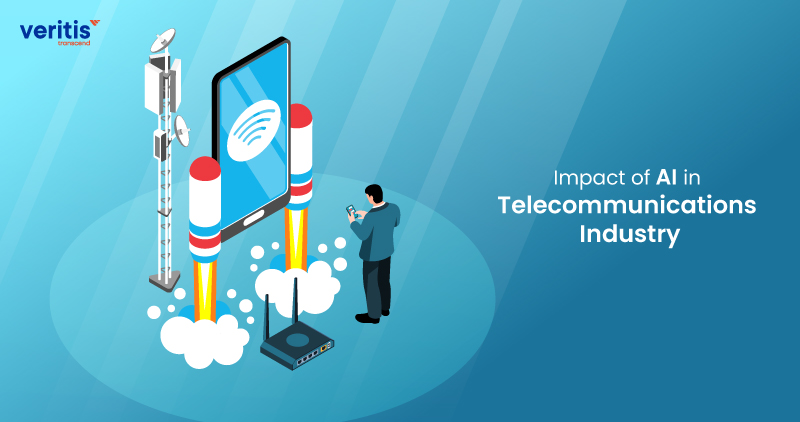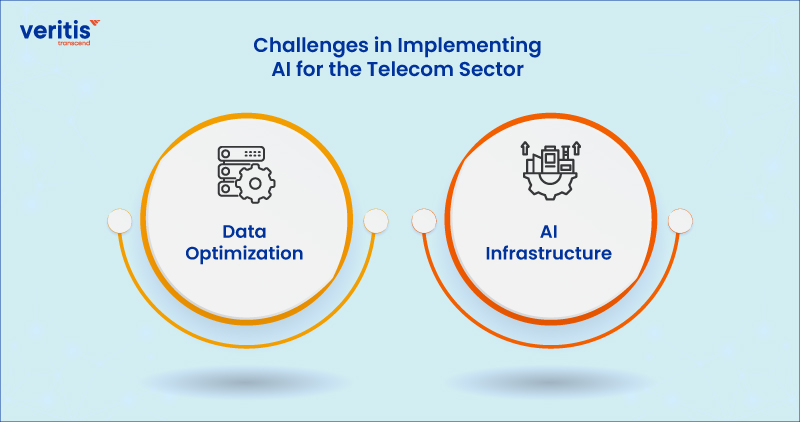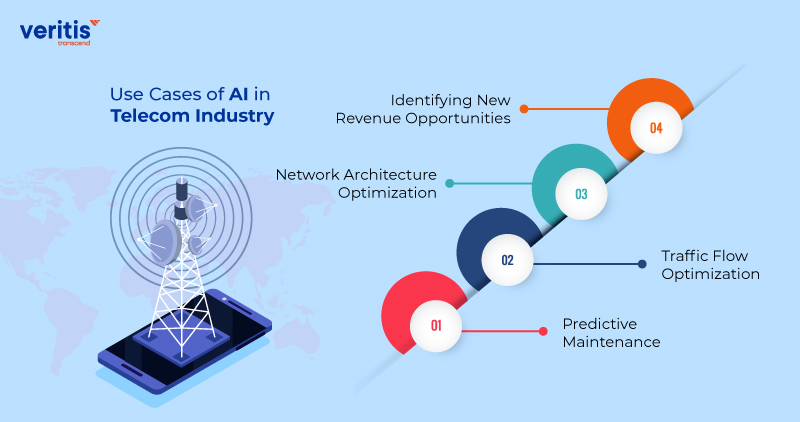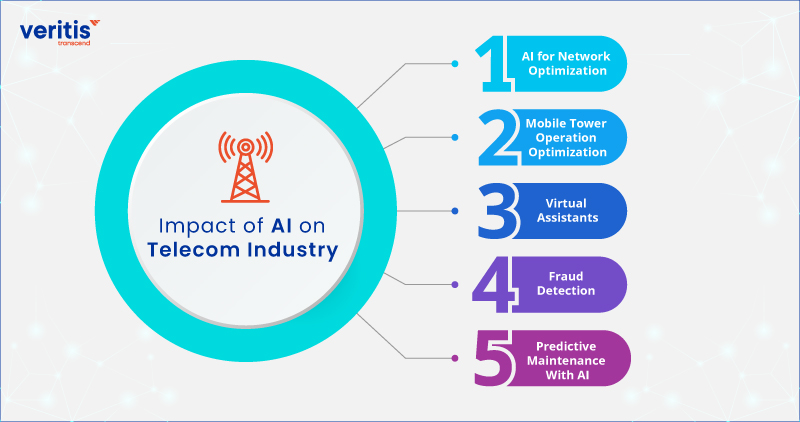
Table of contents
- AI-Driven Customer Service in Telecom
- Challenges in Implementing AI for Telecom Sector
- Why AI is Well-suited for the Telecom Industry
- Use Cases of AI in Telecom Industry
- Impact of AI in Telecom Industry
- AI in Telecom Network Security
- AI and IoT Integration in Telecom Services
- Future Trends of AI in the Telecom Industry
- Conclusion
Telecommunication firms have historically encountered numerous challenges arising from diverse issues, such as network operation and infrastructure issues, intricate networking systems, inefficient resource utilization, customer support challenges, network outages, and the growing bandwidth demand.
Integrating automation and artificial intelligence (AI) in the telecommunications sector enhances the potential for generating substantial revenue, fortifies customer relationships through identifying individualized needs, and enhances network capabilities. AI for IT operations is crucial in improving network management and service delivery, enabling more proactive and efficient issue resolution.
As of 2023, the AI domain in the telecom industry is marked by significant growth, with a market size of USD 841.85 million in 2023 and a projected increase to USD 2808.96 million by 2028, representing a notable Compound Annual Growth Rate (CAGR) of 27.25% from 2023 to 2030.
Telecom AI applications in telecom showcase tangible benefits, with 73% of companies witnessing increased revenue through AI-driven telecom services network optimization, 80% reporting reduced costs in customer service with AI-powered chatbots and virtual assistants, and a substantial 90% success rate in real-time fraud detection using AI, as reported by sources like The Fast Mode and Netguru.
The business impact of AI in telecommunications industry is evident in enhanced operational efficiency, acknowledged by 70% of telecom companies. Additionally, AI contributes to a better customer experience, with 65% of customers expressing higher satisfaction in AI-powered interactions, as highlighted by sources such as NJFX and TechSee. According to insights from LinkedIn, 55% of companies plan to introduce new AI-powered services in 2024, indicating a trend toward diversification and exploring novel revenue streams.
However, these advancements are not without challenges, as 60% of consumers express concerns about data privacy in AI-powered network optimization services, and there is a notable risk of job displacement, with 45% of telecom jobs at risk of automation by 2030, as reported by The Fast Mode. Additionally, undetected biases in algorithms contribute to the failure of 33% of AI projects, as highlighted by Netguru.
Request a Personalized Consultation
AI-Driven Customer Service in Telecom
The AI in telecommunication market is skyrocketing, redefining how service providers engage with customers. From real-time issue resolution to hyper-personalized interactions, AI in telecommunications eliminates frustrating hold times and automates complex support tasks. AI-enabled chatbots and virtual assistants ensure 24/7 availability, cutting operational costs while boosting customer satisfaction. For telecom giants, AI is the key to transforming customer engagement, making interactions smarter, faster, and more personalized than ever before. In an industry where speed and efficiency define success, AI in telecommunications powers instant resolutions, predictive support, and seamless interactions. Organizations that fail to integrate AIOPS services risk falling behind as customer expectations soar.
The future of AI in telecom industry is accelerating toward predictive analytics and proactive solutions. AI detects network issues before they impact users, preventing service disruptions. Advanced NLP and machine learning enhance voice and text interactions, ensuring seamless customer support. Leading companies investing in AI telecom are already experiencing reduced churn rates and higher engagement. The message is clear: AI in telecommunication isn’t the future—it’s happening now.
Challenges in Implementing AI for Telecom Sector

1) Data Optimization
Within the telecom sector, numerous organizations acknowledge that the potential benefits presented by AI are matched, if not surpassed, by the obstacles they are poised to encounter. Specifically, achieving success with AI in telecom necessitates organizations to gather extensive datasets, incorporating information shared by external partners.
Following this, the data must be swiftly and accurately moved to appropriate locations, undergo rapid processing to ensure timely results, and finally, organizations must take decisive actions based on the insights derived from the data to enhance business value.
This entails balancing these tasks while also monitoring costs and sustainability metrics. Furthermore, even after AI integration in telecom models begins producing results, these processes must be repeated continuously to maintain the models’ accuracy over time.
2) AI Infrastructure
Meeting these demands is a small feat, and it is understandable why numerous network service providers (NSPs) express concerns about needing the necessary infrastructure and internal expertise. From an infrastructure standpoint, effective AI implementation is most optimally achieved in a distributed manner. The entire AI integration in telecom workflow hinges on an iterative cycle involving model training and inference, requiring distinct infrastructure specifications.
- Due to their heightened sensitivity to latency, model inference workloads are most effectively hosted at the digital edge.
- Conversely, as model training demands more resources, it is better accommodated in a core data center or the public cloud.
Managing various AI workloads in diverse locations may pose a challenge for NSPs. Leveraging a distributed digital infrastructure platform such as Platform Equinix®, with its worldwide colocation presence, digital infrastructure services deployable at software speed, and rich ecosystems of partners and service providers, could assist NSPs in simplifying complexities and unlocking the full potential of AI use cases.
Useful link: 7 Essential AI Tools Every CTO Should Be Familiar With
AI Applications in Telecom Fraud Detection
1) AI-Enabled Fraud Prevention
The AI in telecommunication market is reshaping fraud detection, allowing telecom providers to identify and stop threats before they cause damage. AI-driven systems analyze billions of transactions in real time, flagging anomalies that indicate fraud. From SIM swap fraud to fake subscriptions, AI in telecommunications provides a robust shield against evolving threats.
2) Real-Time Anomaly Detection with AI
Traditional fraud detection methods struggle to keep pace with sophisticated cyber threats. AI in telecommunication uses machine learning algorithms to track unusual behaviors, such as sudden call spikes, account takeovers, or location mismatches. By analyzing historical patterns, AI telecom predicts and blocks fraudulent activities before they impact customers.
3) Predictive Analytics
The future of AI in telecom industry is all about predictive intelligence. AI-driven fraud detection models assess risks based on customer behavior, device usage, and payment history. With predictive analytics, telecom providers can proactively secure networks, reducing revenue loss and strengthening trust.
4) Automating Fraud Investigations with AI
Fraud teams can no longer depend on manual processes to track fraudsters. AI in telecommunications automates fraud investigations by cross-referencing multiple data sources and detecting hidden patterns. AI-powered risk scoring enables telecom operators to prioritize threats, streamline investigations, and reduce response times.
AI-Driven Voice and SMS Fraud Protection
As fraudsters exploit voice and SMS cha5) nnels, AI telecom solutions offer voice biometrics and AI-driven spam detection to counter threats. AI flags suspicious calls filters spam messages, and identifies robocalls in real time. With AI fortifying telecom security, operators can protect their networks and customers from emerging fraud schemes.
The AI in telecommunication market is not about improving efficiency—it’s about safeguarding revenue and customer trust. Telecom leaders who embrace AI-driven fraud detection will stay ahead in an industry where security and innovation go hand in hand.
Why AI is Well-suited for the Telecom Industry
The telecom industry’s keen interest in AI stems from the immense potential for self-transformation. According to a recent report by Frost & Sullivan, AI is anticipated to evolve into the fundamental technology driving telecommunications services:
“AI technologies offer opportunities to revolutionize telecom services and generate substantial business value.”
The report highlights that telcos identify enhanced customer experience and streamlined network operations as the top two advantages of integrating AI in telecommunications into their practices, cited by 71% and 63% of surveyed telcos, respectively.
As telcos strive to address AI challenges and realize these benefits, they may find themselves better equipped to adapt than they realize. The AIOps solutions for the telecommunications industry have long been accustomed to intricate operational models, and the lessons learned from constructing such models over the years can be applied to support future AI endeavors.
For instance, network service providers (NSPs) that have established 5G networks recently are likely to observe significant parallels between 5G and AI workloads. Both entail managing extensive infrastructure spanning numerous endpoints across diverse edge locations.
Use Cases of AI in Telecom Industry

Telecommunication automation with AI, which has mastered the art of handling intricate service combinations and optimizing automation, now views AI as a logical continuation of its operations. Consequently, they are leveraging AI solutions for the telecommunications industry to explore various use cases, including:
1) Predictive Maintenance
2) Traffic Flow Optimization
3) Network Architecture Optimization
4) Identifying New Revenue Opportunities
1) Predictive Maintenance
Ensuring an outstanding user experience is paramount for Network Service Providers (NSPs) catering to enterprise customers. Given their critical reliance on seamless network services, these customers expect to function consistently, regardless of time or location. To meet this demand, NSPs can employ insights derived from artificial intelligence (AI) to detect anomalies and proactively schedule maintenance, mitigating potential outages.
A growing number of NSPs have already initiated using predictive AI models to enhance the maintenance of networking equipment and the fundamental infrastructure that sustains it. The goal of predictive maintenance in the telecommunication industry innovation is the realization of self-healing networks. These advanced networks can remain operational by autonomously identifying and resolving issues without human intervention.
While the concept of self-healing networks is not novel, the present juncture signifies that Network Service Providers (NSPs) now possess the essential capabilities to actively pursue the implementation of self-healing networks on a large scale. The recent alignment of predictive AI models with automation and software-defined networking capabilities represents a crucial component of this puzzle that has recently come together.
2) Traffic Flow Optimization
Network Service Providers (NSPs) have long utilized automation to manage and redirect traffic effectively. Integrating AI capabilities allows for a heightened optimization level in traffic routing. AI tools can analyze the traffic flow over an extended period, providing NSPs with valuable insights to refine their routing and capacity management strategies. By adopting an AIOps strategy, NSPs can further enhance their decision-making processes, automating network management tasks and proactively addressing potential issues before they disrupt service.
The overarching goal remains enhancing customer and end-user experiences: AI-enabled networks can adeptly identify and respond to unforeseen surges in traffic, swiftly introducing temporary capacity to preempt delays that might compromise user satisfaction.
AI capabilities allow network service providers (NSPs) to oversee network components intelligently during periods of lower-than-anticipated traffic. This proves especially beneficial in the mobile domain, where the user count served by a specific radio access network (RAN) can fluctuate significantly. Leveraging AI solutions for telecommunication industry innovations, NSPs can instruct these RANs to transition into low-power mode or even shut down when not in use, facilitating a more efficient operation of 5G networks.
3) Network Architecture Optimization
Present-day Network Service Providers (NSPs) acknowledge that the network architectures that proved successful in the past may not align with the demands of the current business environment. Novel approaches to designing, constructing, and overseeing fixed and mobile networks are imperative to accommodate the latest digital telecom AI applications and meet users’ evolving needs.
An illustration of this is the integration of digital twins. By combining AI and digital twin technologies, NSPs can obtain a highly detailed and precise assessment of their network’s performance across diverse real-world scenarios. This enables informed decision-making regarding the strategic placement of network components and effective management strategies for optimal outcomes. As the demand for 5G applications, such as gaming and intelligent cities, surges, NSPs can confidently expand their networks to better cater to the growing needs of these telecom AI applications.
4) Identifying New Revenue Opportunities
Employing AI models to better understand customer preferences and their value is not exclusive to telecommunication industry innovations. Nevertheless, this sector presents particularly favorable prospects. For example, Network Service Providers (NSPs) can scrutinize usage patterns, extracting detailed insights into how customers utilize their networks and the underlying motivations behind their usage.
Utilizing these insights, NSPs can enhance their ability to meet customer expectations by offering more customized and specific services. This may involve implementing network slicing, where the operator provides distinct service classes tailored to different user requirements. Consequently, NSPs can assist diverse customers in fulfilling their precise needs—whether related to latency, reliability, capacity, security, or other factors—while utilizing the same physical network infrastructure for all users. Network slicing enables the provision of desired higher-tier services for customers willing to pay a premium.
Useful link: Overcoming Challenges: Implementing Generative AI in Healthcare
Impact of AI in Telecom Industry

1) AI for Network Optimization
AI is crucial in enabling Communication Service Providers to construct self-optimizing networks. These networks empower operators to automatically enhance network quality by leveraging traffic information categorized according to region and time zone.
Artificial Intelligence (AI) applications in the telecommunications sector deploy sophisticated algorithms to identify patterns within data. This empowers telecom companies to detect and predict network anomalies, enabling proactive issue resolution before customers experience any negative impacts. This indicates how AI is transforming the field of advanced analytics in the telecom industry.
2) Mobile Tower Operation Optimization
The telecom sector faces another challenge with the routine maintenance of mobile towers, which necessitates on-site inspections to ensure proper functioning. AI-powered network optimization video cameras can be installed in mobile towers to address this issue. These cameras provide real-time notifications to Communication Security Providers during hazardous incidents and sound alarms in cases of fire, smoke, or natural disasters.
3) Virtual Assistants
Virtual assistants represent a burgeoning AI trend within the telecom industry. They aim to address the substantial volume of support requests related to installation, setup, troubleshooting, and maintenance that frequently inundate customer support centers. Through AI, telecom companies can introduce self-service capabilities, guiding customers through the installation and operation of their devices independently.
For example, Vodafone’s AI assistant, Julia, is accessible on its website and adept at aiding customers with various tasks, including technical support and handling invoicing queries. Furthermore, it compiles valuable data, providing insights to Vodafone for informed decision-making in the future of AI in telecommunications. Integrating artificial intelligence in automating customer service has brought a revolutionary change in advanced analytics in the telecom industry.
4) Fraud Detection
The telecommunications sector is one of the most susceptible industries to fraud, experiencing the most significant financial losses from cybersecurity breaches. Traditional security smart telecommunication systems and artificial intelligence in telecommunications are proficient at recognizing common issues but must improve in identifying or predicting potential threats.
Telecom fraud manifests in various forms: subscription fraud, identity theft, international revenue-sharing fraud, voicemail fraud, and voice phishing calls. Telecommunication automation with AI data comprises susceptible details, including source and destination numbers, call duration, call type, geography, region, and account billing information.
Artificial intelligence has significantly simplified the implementation of algorithms within the telecom sector, enabling the detection and response to fraudulent activities through network optimization AI. Moreover, this network optimization AI substantially reduces response times, enabling telecom businesses to thwart threats before they exploit internal information smart telecommunication systems.
This is a notable illustration of how predictive maintenance AI integration in telecom plays a pivotal role in safeguarding companies and customers from fraud.
5) AI in Predictive Maintenance
The recent trend in the telecom industry is using AI-driven predictive analytics for telecom services, aiding telcos in delivering enhanced services. This involves leveraging data, advanced algorithms, and contemporary forecasting techniques to predict the future of AI in telecommunications outcomes based on historical data. Telecom companies can employ these data-driven insights to continuously monitor equipment conditions, anticipate potential failures, and take proactive measures to address issues with communication hardware, including cell towers, power lines, and servers in data centers.
Soon, network automation and intelligence integration will enhance root cause analysis and enable more accurate fault prediction. In the long term, these technologies will form the groundwork for attaining strategic goals, including creating innovative, automated customer service experiences and handling business demands more efficiently.
The U.S. telecommunications giant AT&T employs machine learning to improve its end-to-end incident management process by identifying real-time network issues. Through predictive maintenance AI, the technology can manage 15 million alarms daily, swiftly resolving service disruptions before customers experience any interruption. Additionally, AT&T utilizes AI integration in telecommunications for maintenance operations, employing drones to extend LTE network coverage. The analysis of video data captured by these drones is leveraged for technical support and infrastructure maintenance of the company’s cell towers.
AI in Telecom Network Security

1) AI-Driven Threat Detection
Cyber threats in telecom are evolving, and traditional security measures can’t keep up. AI in telecommunication enables real-time threat detection by analyzing massive amounts of network data and detecting suspicious activities. As the AI in telecommunication market grows, telecom operators are leveraging AI to detect and neutralize security threats before they escalate.
2) Predictive Security
The future of AI in telecom industry is all about predictive defense. AI models anticipate security breaches by analyzing past incidents and detecting anomalies. AI telecom solutions use machine learning to block unauthorized access, safeguard customer data, and prevent fraud before it happens.
3) Automated Incident Response
In telecom, every second counts when dealing with security breaches. AI in telecommunications automates response mechanisms, instantly isolating compromised systems and mitigating risks. AI-enabled security solutions minimize downtime and enhance network resilience, ensuring seamless user communication.
4) AI and 5G Security
With 5G adoption expanding, telecom networks face new security challenges. AI in telecommunication enhances 5G security by detecting sophisticated cyber threats targeting ultra-fast networks. AI safeguards IoT devices, edge computing, and cloud infrastructure, making AI telecom security indispensable.
5) Strengthening Network Integrity with AI-Driven Authentication
Hackers exploit vulnerabilities in user authentication, leading to breaches and identity theft. AI in telecommunications strengthens authentication with biometric verification, behavioral analytics, and AI-enabled risk assessments. Telecom providers integrating AI-driven security experience fewer breaches and higher customer trust.
As the AI in telecommunication market surges, industry leaders recognize that AI is transforming network security, making it smarter, stronger, and more proactive than ever before. The companies investing in AI telecom security today are setting the foundation for a safer, more resilient telecom future.
AI and IoT Integration in Telecom Services

1) AI and IoT
The AI in telecommunication market is evolving rapidly, and its integration with IoT is redefining telecom services. AI processes vast IoT-generated data in real-time, optimizing network performance and reducing latency. With billions of connected devices, AI in telecommunications ensures seamless communication, intelligent automation, and enhanced service quality.
2) Predictive Maintenance
Network failures disrupt enterprises and frustrate customers. AI telecom solutions, combined with IoT sensors, predict equipment failures before they occur. AI-driven predictive maintenance analyzes network health, reducing costly outages and ensuring uninterrupted connectivity. This proactive approach boosts efficiency and enhances customer satisfaction.
3) Intelligent Network Optimization with AI and IoT
The future of AI in telecom industry revolves around self-optimizing networks. AI-powered IoT solutions monitor bandwidth usage, detect congestion, and adjust network resources in real-time. AI in telecommunication enhances 5G infrastructure, ensuring faster, more reliable connections, especially in smart cities and industrial automation.
4) AI-Driven IoT Security
With IoT expanding the attack surface, cybersecurity threats are a major concern. AI in telecommunications strengthens network security by detecting anomalies in device behavior, identifying threats, and preventing cyberattacks. AI-driven security frameworks provide real-time monitoring, ensuring telecom networks remain resilient.
5) Smart Customer Experiences
Telecom providers are leveraging AI in telecommunication and IoT to personalize services like never before. AI analyzes IoT data to offer customized plans, real-time troubleshooting, and predictive customer support. This integration enhances user experience, reduces churn, and increases revenue for telecom operators.
The AI in telecommunication market is at a turning point, and integrating AI with IoT is driving the next wave of innovation. Today, telecom leaders embracing AI telecom solutions will dominate the future, delivering smarter, more efficient, and highly secure connectivity.
Future Trends of AI in the Telecom Industry
1) AI-Powered 5G Networks
The AI in telecommunication market is evolving alongside 5G, with AI playing a critical role in network optimization, predictive maintenance, and traffic management. AI automates 5G network configurations, ensuring ultra-low latency and seamless connectivity. As 5G expands, AI in telecommunications will be the backbone of real-time, high-speed data transmission.
2) Hyper-Personalized Customer Experiences with AI
Telecom companies are using AI telecom solutions to revolutionize customer engagement. AI-driven analytics track user behavior, predict service needs and offer personalized plans. The future of AI in telecom industry lies in automated, AI-powered virtual assistants and chatbots that enhance customer interactions while reducing service costs.
3) AI and Edge Computing
With the rise of IoT devices, AI and edge computing are reshaping telecom networks. AI in telecommunication processes data closer to the source, reducing latency and improving efficiency. This shift enables telecom providers to offer real-time services, from smart city applications to industrial automation, without overloading central servers.
4) AI-Driven Security
Cyber threats are escalating, making AI a crucial tool for network security. AI in telecommunications detects and mitigates security breaches by analyzing anomalies in real-time. AI-powered security frameworks prevent fraud, safeguard user data, and ensure telecom networks remain resilient against cyberattacks.
5) Autonomous Networks
The future of AI in telecom industry points toward self-optimizing and self-healing networks. AI enables telecom infrastructure to detect faults, reroute traffic, and fix issues autonomously. This next-gen capability will drive efficiency, cut operational costs, and redefine how telecom providers manage network reliability.
As the AI in telecommunication market grows, industry leaders must harness AI to stay ahead. Today’s companies investing in AI telecom will set the benchmark for intelligent, automated, and future-ready telecom services.
Case Study: Transforming Automotive IT Operations with AIOps
A global automotive company turned to Veritis to modernize its IT landscape by implementing AIOps, a strategy increasingly relevant to industries such as telecommunications.
Challenge: The organization faced persistent system inefficiencies, delayed incident resolution, and limited visibility across its IT infrastructure, resulting in service disruptions.
Solution: Veritis deployed an AI-powered AIOps solution, enabling predictive analytics, automated incident management, and real-time system monitoring to ensure seamless operations.
Results:
- Significant reduction in downtime through proactive issue detection
- Faster response times using intelligent automation
- Improved operational efficiency and service reliability
This case illustrates how AI-driven operations, such as AIOps, can deliver measurable improvements in uptime and agility benefits that directly apply to the telecom industry as it scales and evolves.
Read the Full Case Study: Transforming Automotive Operations with AIOps
Conclusion
Artificial intelligence has proven to be a valuable tool in the telecom sector. Its influence on the industry has created exceptionally personalized products, streamlined fulfillment processes, and more effective network management. Furthermore, it empowers telecommunications AI trend operators to offer customers more appealing services, significantly elevating customer retention rates.
Notably, Veritis, a recipient of accolades such as the Stevie and Globee Business Awards, is a leading provider of AI services, further exemplifying the industry’s commitment to leveraging AI’s transformative power for enhanced business solutions.
Looking for Support? Schedule A Call
Also Read:
- AI and Cybersecurity: Defending Against Evolving Threats
- What is Generative AI: An Ultimate Guide to Amazon Generative AI Tools
- AIOps Vs MLOps: Understanding Significant Differences
- A Guide to APIOps, the Collaborative Approach for API Production
- AIOps Use Cases: How Artificial Intelligence is Reshaping IT Management
- All You Need to Know about Artificial Intelligence as a Service (AIaaS)